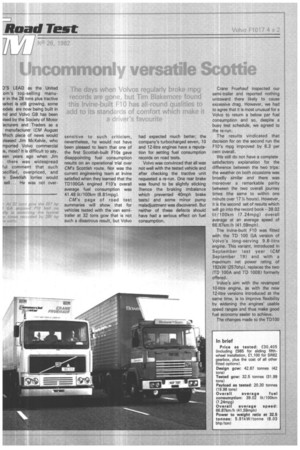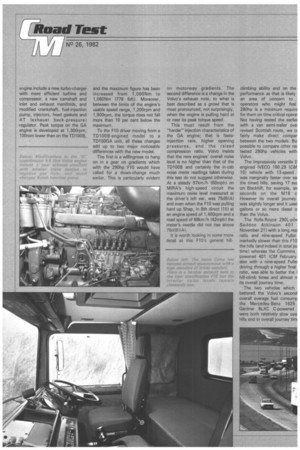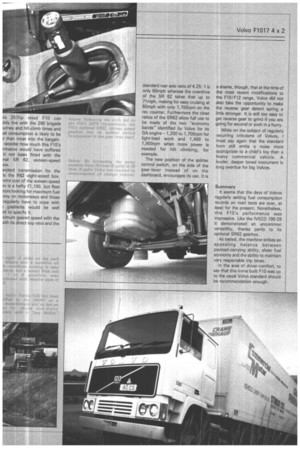records are goiJ., Tim Blakenwre this Irvine-built F'10 has all-round
Page 101

Page 102

Page 103

If you've noticed an error in this article please click here to report it so we can fix it.
qualities 1dd to its standards of comfort which a -driver's favourit
D'S LEAD as the United om's top-selling manum in the 28 tons plus tractive tarket is still growing, some odels are now being built in nd and Volvo GB has been lised by the Society of Motor acturers and Traders as a manufacturer (CM August Vhich piece of news would Jleased Jim IVIcKelvie, who mported Volvo commercial most? It is difficult to say. een years ago when Jim
there was widespread ful comment that such )ecified, overpriced, and -e Swedish lorries would sell... He was not over
sensitive to such criticism, nevertheless, he would not have been pleased to learn that one of the first Scottish-built F1Os gave disappointing fuel consumption results on an operational trial over CM's Scottish route. Nor was the current engineering team at Irvine satisfied when they learned that the TD100GA engined F10's overall average fuel consumption was 41.48 lit/100km (6.81mpg).
CM's page of road test summaries will show that for vehicles tested with the van semitrailer at 32 tons gcw that is not such a disastrous result, but Volvo had expected much better; the company's turbocharged seven, 10 and 12-litre engines have a reputation for setting fuel consumption records on road tests.
Volvo was convinced that all was not well with the tested vehicle and after checking the tractive unit requested a re-run. One rear brake was found to be slightly sticking (hence the braking imbalance which prevented 40mph brake tests) and some minor pump maladjustment was discovered. But neither of these defects should have had a serious effect on fuel consumption. Crane Fruehauf inspected our semi-trailer and reported nothing untoward there likely to cause excessive drag. However, we had to agree that it is most unusual for a Volvo to return a below par fuel consumption and so, despite a busy test schedule, we agreed to the re-run.
The results vindicated that decision for on the second run the F10's mpg improved by 6.3 per cent overall.
We still do not have a complete satisfactory explanation for the difference between the two trips: the weather on both occasions was broadly similar and there was moreover a remarkable parity between the two overall journey times (the same to within one minute over 17 1/2 hours). However, it is the second set of results which will go into the record book —39.02 lit/100km (7.24mpg) overall average at an average speed of 66.87km/h (41.59mph).
The Irvine-built F10 was fitted with the TD 100 GA version of Volvo's long-serving 9.6-litre engine. This variant, introduced in September last year (CM September 19) and with a maximum net power rating of 192kW (257bhp), replaces the two (TD 100A and TD 100B) formerly offered.
Volvo's aim with the revamped 10-litre engine, as with the new 12-litre versions introduced at the same time, is to improve flexibility by widening the engines' usable speed ranges and thus make good fuel economy easier to achieve.
The changes made to the TD100 engine include a new turbo-charger with more efficient turbine and compressor, a new camshaft and inlet and exhaust manifolds, and modified crankshaft, fuel-injection pump, injectors, head gaskets and AT (exhaust back-pressure) regulator. Peak torque on the GA engine is developed at 1,300rpm, 10Orprn lower than on the TD100B, and the maximum figure has been increased from 1,000Nm to 1,060Nm (778 lbft). Moreover, between the limits of the engine's usable speed range, 1,200rpm and 1,900rpm, the torque does not fall more than 10 per cent below the maximum.
To the F10 driver moving from a TD100B-engined model to a TD100GA unit, all these changes add up to two major noticeable differences with the new model.
The first is a willingness to hang on in a gear on gradients which with the 290hp F10 would have called for a down-change much earlier. This is particularly evident on motorway gradients. The second difference is a change in the Volvo's exhaust note, to what is best described as a growl that is most pronounced, not surprisingly, when the engine is pulling hard at or near its peak torque speed.
This must result from the "harder" injection characteristics of the GA engine; that is faster injection rate, higher opening pressures, and the raised compression ratio. Volvo insists that the new engines' overall noise level is no higher than that of the TD100B and certainly the in-cab noise meter readings taken during this test do not suggest otherwise. At a steady 97km/h (60mph) on MIRA's high-speed circuit the maximum noise level measured at the driver's left ear, was 75dB(A) and even when the F10 was pulling hard up Shap, in 8th direct (15) at an engine speed of 1,400rpm and a road speed of 68km/h (42mph) the meter's needle did not rise above 76cil 8)(A).
It is worth looking in some more detail at this F10's general hit
climbing ability and on the performance as that is likely an area of concern to operators who might feel 290hp is a minimum require for them on time critical operat Not having tested the earlier with a van semi-trailer ovei revised Scottish route, we fairly make direct compar between the two models. Bu. possible to compare other rec tested 290hp vehicles with Volvo.
The impressively versatile engined IVECO 190.29 (CM 10) vehicle with 13-speed I was marginally faster over ea, the timed hills, saving 17 sec on Blackhill, for example, an seconds on the M18 cl However its overall journey was slightly longer and it used gallons or so more diesel a than the Volvo.
The Rolls-Royce 290L-pov Seddon Atkinson 401 November 211 with a long real ratio and nine-speed Fuller markedly slower than this F10 the hills (and indeed in total jot time) whereas the Cummins powered 401 (CM February also with a nine-speed Fullei driving through a higher final ratio, was able to better the hill-climb times and almost rr its overall journey time.
The two vehicles which bettered the Volvo's second overall average fuel consump the Mercedes-Benz 1625 Gardner 8LXC C-powered were both relatively slow ove hills and in overall journey timi is 257hp rated F10 can inly live with the 290 brigade rurney and hill-climb times and lel consumption is likely to be r than most into the bargain. wonder how much this F10's mance would have suffered it not been fitted with the nal SR 62, sixteen-speed Indard transmission for the is the R62 eight-speed box. Ixtra cost of the sixteen-speed )r) is a hefty £1,100, but fleet tors looking for maximum fuel )my on motorways and those regularly have to cope with gradients would be well .K1 to specify it.
ximum geared speed with the with its direct-top ratio and the standard rear axle ratio of 4.25: 1 is only 60mph whereas the overdrive of the SR 62 takes that up to 71mph, making for easy cruising at 60mph with only 1,700rpm on the rev counter. Furthermore the close ratios of the SR62 allow full use to be made of the two "economy bands" identified by Volvo for its GA engine 1,200 to 1,700rpm for light-load work and 1,400 to 1,900rpm when more power is needed for hill climbing, for example.
The new position of the splitter control switch, on the side of the gear-lever instead of on the dashboard, encourages its use. It is a shame, though, that at the time of the most recent modifications to the FIO/F12 range, Volvo did not also take the opportunity to make the reverse gear detent spring a little stronger. It is still too easy to get reverse gear to grind if you are going for second or sixth in a hurry.
While on the subject of regularly recurring criticisms of Volvos, I must say again that the standard horn still emits a noise more appropriate to a child's toy than a heavy commercial vehicle. A louder, deeper toned instrument is long overdue for big Volvos.
Summary It seems that the days of Volvos regularly setting fuel consumption records on road tests are over, at least for the present. Nonetheless, this FIO's performance was impressive. Like the IVECO 190-29 it demonstrated an uncommon versatility, thanks partly to its optional SR62 gearbox.
As tested, the machine strikes an appealing balance between payload-carrying ability, sheer fuel economy and the ability to maintain very respectable trip times.
In the area of driver-comfort, to say that this Irvine built F10 was up to the usual Volvo standard should be recommendation enough.


















































































































